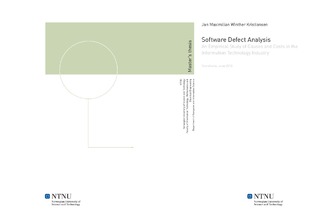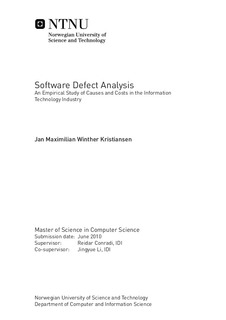| dc.description.abstract | The area of software defects is not thoroughly studied in current research, even though it is estimated to be one of the most expensive topics in industries. Hence, certain researchers characterise the lack of research as a scandal within software engineering. Little research has been performed in investigating the root causes of defects, even thought we have classification schemes which aims to classify the what, where and why regarding software defects. We want to investigate the root causes of software defects through both qualitative and quantitative methods.We collected defect reports from three different types of projects in the defect tracking system of Company X. The first project was a project concerned with development of a general core of functionality which other projects could use. The second was a project aim at the mass-software market, while the third project was tailored software to a the needs of a client. These defect reports were analysed by both qualitative and quantitative methods. The qualitative methods were based on grounded theory. The methods tried to establish a theory of why some defect require extensive effort to correct through analysis of the discussions in the defect reports. The quantitative methods were used to describe differences between defects which required extensive or little effort to correct.In the qualitative analysis, we found four main root causes which explain why a group of defects require extensive effort to correct: hard to determine the location of the defect, long discussion or clarification of the defect, incorrect corrections introduces new defects, and implementation of missing functionality or re-implementation of existing functionality. A comparison between the four root causes and project types revealed the root causes were influenced by the project types. The first project had a larger degree of discussion and incorrect corrections than the second and third projects. The second and third projects were more concerned with hard to locate defects and implementation of missing functionality or re-implementation of functionality. Similarly, a comparison against another organisation showed there were differences with regard to root causes for extensive effort. This showed how systematic analysis of defect reports can yield software process improvement opportunities.In the quantitative analysis, we found differences among extensive or little effort to correct defects and project types. The extensive to correct defects of the first project were due to incorrect algorithms or methods, injected during the design phase, and high risk of regressions. In the second project, the extensive effort to correct defects were due to algorithms, methods, functions, classes and objects, were concerned with the core, platform, and user interface layers and injected during the design phase, and lower regression risks. In the third project, the defects which required extensive effort to correct were due to assignation and initialisation of variables, or function, classes and objects, related to the core-layer, injected during the coding phase, and average regression risk of medium. The little effort to correct defects in the core project were concerned with assignation or initialisation of variables, checking statements, lower regression risk, injected during the code phase. In the second project, easy to correct defects were concerned with checking statements in the code which had a low regression risk. In the third project, defects which required little effort to correct were due to checking statements, interfaces with third party libraries, lower regression risk and stem from requirements. The quantitative analysis contained high levels of unspecified values for little effort to correct defect. The levels of unspecified attributes were lower for defects which required extensive effort to correct.We concluded there were differences among project types with regard to root causes for defects, and that there were differences similar between different levels of effort required to correct defects. However, the study were not able to measure how these differences influenced the root causes as the study was performed in a descriptive manner. | nb_NO |

